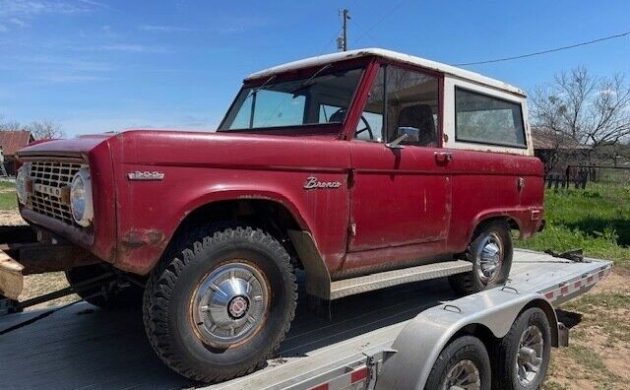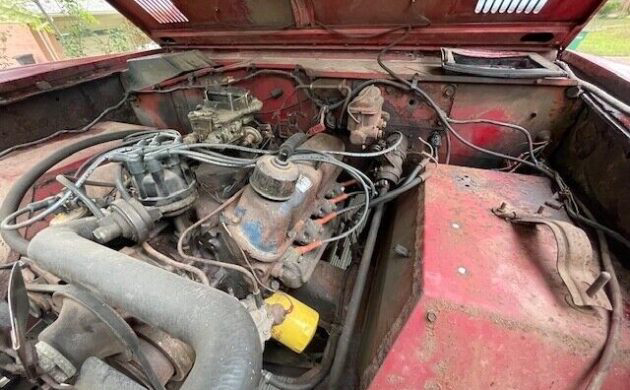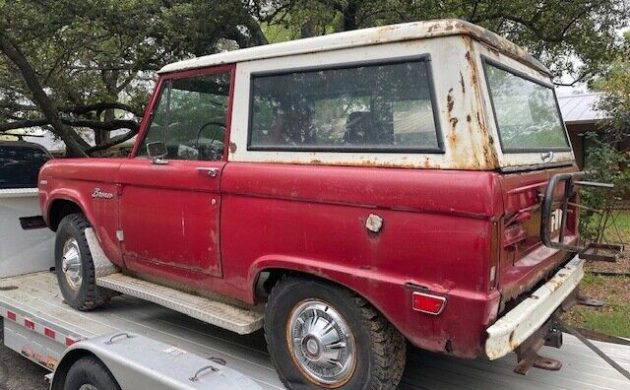
Vehicles like this 1969 Ford Bronco should allay the fears of some enthusiasts that the supply of classic barn finds will eventually disappear. The First Generation Bronco is desirable, and climbing values reflect this fact. Our feature Bronco emerged from a Texas barn in the last few days and is a relatively unmolested machine worthy of a faithful restoration. The seller feels it should go to a new home with someone who can do it justice. Therefore, they have listed the Ford here on eBay in San Antonio, Texas. Bidding has raced to $8,522 as a result of strong interest.

The history of this Bronco is unclear, although the seller believes it has hibernated for many years. The first thing I noticed is that apart from the side steps and extended front bumper mounts, the exterior is as it left the factory. The first owner ordered it in Royal Maroon, and while the paint is extremely tired, the steel beneath is surprisingly solid. It is far from rust-free, but a dry-climate existence has minimized the problems. There is visible penetration in the lower body panels, and I think it may have the typical rust in the front inner fenders. However, prone areas like the pillars look structurally sound. We receive no information on the floors, but the interior shots suggest they may sport nothing beyond heavy surface corrosion. With many companies producing replacement parts, addressing unidentified shortcomings should be straightforward. The glass and trim are acceptable for a driver-grade build, and the Bronco retains its original hubcaps.

If potential buyers are considering a faithful restoration, the news is slightly less positive inside this Bronco. The original front seats have been replaced with a set of highback buckets, and someone has cut a hole in the dash where the ashtray and speaker grille should be. The door trims are gone, and the carpet is a memory. There is some good news because the shifter remains in its rightful place, the pad might be okay, and there are no aftermarket additions. The seats may not be a significant hurdle because originals suitable for restoration frequently appear on the usual online auction sites for under $500. Securing those and a trim kit would go a long way towards reclaiming the interior’s former glory.

Ford offered 1969 Bronco buyers two engine choices, with this classic’s first owner selecting the optional 302ci V8. The rest of the drivetrain is typical Bronco fare, including a three-speed manual transmission and a dual-range transfer case. In its prime, the V8 produced 205hp and 300 ft/lbs of torque, allowing the Ford to perform well in most circumstances. The seller confirms that the vehicle hasn’t run in years, with the engine bay missing the starter and air cleaner assembly. It is unclear whether the engine turns, but revival may not be difficult if it does. However, factoring a rebuild into the restoration budget is a wise strategy.

The classic market produces some mysteries, and the story of the First Generation Bronco is a prime example. Understanding why a classic Mustang or Pontiac GTO is desirable isn’t challenging, but the Bronco was largely unloved when new. The twenty-six bids submitted on this one prove the situation has changed dramatically. Experts provide various possible reasons why they are now an automotive “must-have,” although pinning down which theory is the most credible is almost impossible. Our feature vehicle hasn’t reached its reserve, and history shows the bid figure will probably need to at least double before that happens. Do you think it will get there?





Underpowered? The Ford 302 was used in everything from Mustangs to F100’s. And while it wasn’t the most potent engine you could get. It was more than adequate. The world was a lot freer back then, and people were a lot smarter. We didn’t need a nanny state to tell us that if you drove your short wheelbase 4×4 into a corner like an MG, it’d be on it’s lid. And the people who bought Bronco’s weren’t using them to drop off the kiddies at private school, and then drive over to the Whole Foods, to pick up a kale salad. These were purpose built vehicles, bought by folks who used them accordingly.
I bought my first new 4WD SUV in the 1970s when 1st gen Broncos were Ford’s only offering. Back then, Broncos were considered more “Utility” than “Sport”. They were mainly owned by people that used them for work; landscapers, ranchers, gas stations and municipalities. I mainly wanted a 4X4 to get to the far away ski hills. I checked out the Bronco, and found it cramped for space, noisy inside, and uncomfortable on high-speed highways. I bought a K5 Blazer. I still have a ’75 in my collection.
Over my 50+ years driving, fixing, restoring and collecting cars, I have owned several that did not live up to the legend. I have owned some that I spent great effort (and expense) to acquire , and restore, only to be disappointed after the first few drives. I suspect some buyers will experience this with these Broncos. Old Broncos do have a definite cool factor, but buyers should have realistic expectations for how they will drive, especially compared to more modern SUVs.
So you would scrap it for $250 bucks rather than selling it for over $50k? Ok
That would make too much sense. These sort of statements are performative in nature and not well thought out, it sounds good and gets applause by the clapping seals but makes little to no sense when you stop to think about it or someone actually tries to implement their plan, which is always someone else’s obligation, never theirs.
Steve R
Too much work. Sellers have to understand why they themselves are selling it and not fixing it. Labor is at least 75-100 an hr. Plus the engine will need rebuilt. Good luck but lets be honest the new Broncos are making the old ones worthless
Sorry but most car guys do their own repairs and the new Bronco has just increased interest in the old ones.